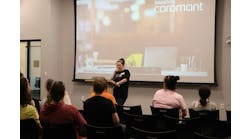Nicole Otte is director of workforce development, and Megan Anders is technical support team manager at Endress+Hauser USA.
According to U.S. census data, the percentage of women in engineering occupations has increased from a mere 3% to 15% over the past 50 years. While the needle is pointed in the right direction, there’s still a lot of room to grow that number. What seem to be the biggest hurdles to women interested in engineering and automation fields? And what difficulties are employers encountering as they work to increase that number?
Nicole Otte, director of workforce development, Endress+Hauser USA: There are smaller candidate pools of women in engineering-degree programs at colleges and universities across the country. These post-secondary institutions have indicated difficulty in attracting students to their programs. While there may be higher percentages in programs such as biomedical and environment engineering, that percentage drastically reduces for programs such as mechanical and electrical engineering.
Also read: 5 ways to find success as a woman in STEM
Director of Workforce Development,
Endress+Hauser USA
With the skilled labor shortage that began pre-pandemic and was heightened by the shutdown, how can organizations capitalize on the availability of women to fill these roles?
Nicole Otte, director of workforce development, Endress+Hauser USA: We have to start attracting females into STEM and engineering programs at younger ages, so that there are higher percentages of females in STEM-education pipelines.
In her relatively famous study, published in the Harvard Business Review, MIT’s Susan Silbey and her colleagues found that women in engineering experienced a significant amount of gender bias not only at the college level, but even more so in internships and co-ops and then when entering the workforce. She estimates that 40% of women who earn an engineering degree either quit or never enter the profession. What can be done to nurture and develop these women, especially early in their careers?
Nicole Otte, director of workforce development, Endress+Hauser USA: Mentoring programs, such as Endress+Hauser’s Women’s Integrated Network (W.I.N.), initiate powerful ways to connect early-career women engineers to advocates and coaches in their organizations and industries.
One of the other findings in Silbey’s report is that the women who participated were hoping to make a more socially conscious impact in their engineering pursuits than the males in the study. What, if anything, does this tell us about gender bias? And, if the report is indicative of a real female desire to make a difference, where might women find those types of jobs to have a positive impact on society and civilization with their engineering and automation expertise?
Nicole Otte, director of workforce development, Endress+Hauser USA: I believe this is indicative based on female students choosing majors where they can easily make a connection to making a difference—for instance, biomedical is about helping people, environmental and sustainability, helping our planet.
Technical Support Team Manager,
Endress+Hauser USA
How can mentoring programs help women to stay the course and feel fulfilled in their automation or engineering pursuits?
Megan Anders, technical support team manager, Endress+Hauser USA: In industries in which women are the minority, it can seem isolating and intimidating to determine the space that you hold. Mentoring programs give mentees the ability to develop, explore and be understood in an environment that facilitates growth and community. Being in a mentoring program myself, it has given me the opportunity to find my voice and have an ally who advocates for me, as well as continues to challenge me in the work I do.
What sorts of initiatives is your company involved with to encourage female participation in the automation field?
Nicole Otte, director of workforce development, Endress+Hauser USA: W.I.N. mentoring and Girls Inc. programming and partnering are examples. We are hosting field trips for elementary and middle-school girls this summer to get them exposed to STEM and making a difference in their communities and world through our process-automation technologies. It will include hands-on and engaging activities to get girls excited about a career in our industry.
Megan Anders, technical support team manager, Endress+Hauser USA: Endress+Hauser has a global Women’s’ Integrated Network (W.I.N.) group to help facilitate opportunities for females in the automation field. Endress+Hauser provides opportunities to participate in national Society of Women Engineers (SWE) conferences, women in leadership trainings and the W.I.N. mentoring program. The company continues to work toward giving women a seat at the table and helping to create a support network within the company to develop a successful career in the automation field.






